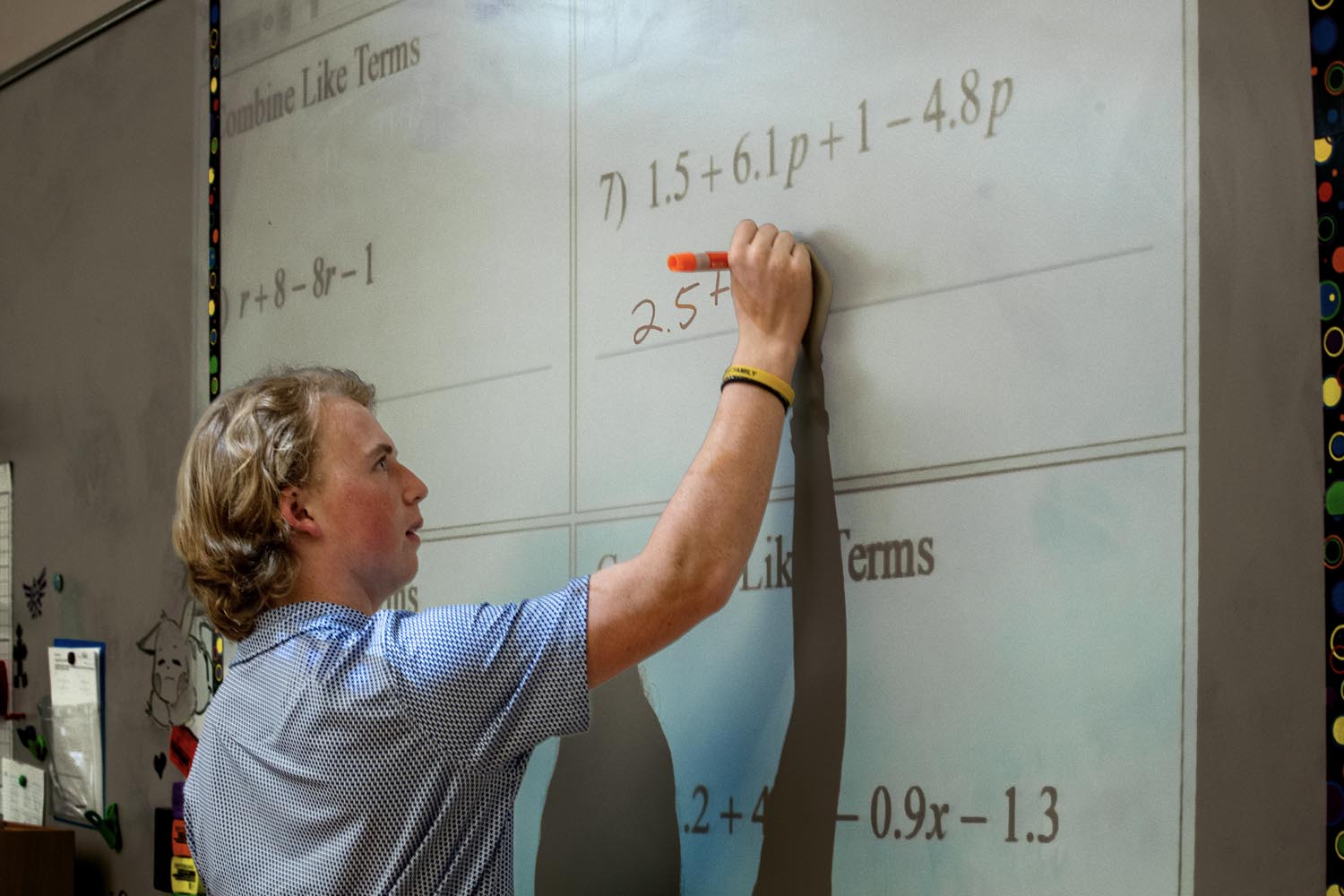
 Mathematics is a way of thinking. It is also a language in itself, a way of expressing ideas that lends itself to solving problems. In teaching mathematics, students are developing this way of thinking to help them become proficient in expressing ideas in the language of mathematics.
Mathematics is a way of thinking. It is also a language in itself, a way of expressing ideas that lends itself to solving problems. In teaching mathematics, students are developing this way of thinking to help them become proficient in expressing ideas in the language of mathematics.
Faculty Members
Mr. Benjamin Boyle
Mr. Jim Jenkins
Mrs. Jeanne Peterson
Mrs. Sarah Ramsey
Algebra I
1 Credit ~ 2 Semesters ~ Prerequisite: None
This is the traditional starting point in high school math sequence. The skills developed in this course include: simplifying variable expressions, solving equations, graphing and problem solving. Most of the course will work in the rational number field, but students will be exposed to simplifying radicals and solving equations with irrational roots.
Algebra I Honors
1 Credit ~ 2 Semesters ~ Prerequisites: Previous academic math grades of 94 or above, and 90 percentile in standardized math test
The objectives of this section includes all the objectives of the regular Algebra I course, but the students will be exposed to more aspects of the theory and to more challenging problems.
Geometry
1 Credit ~ 2 Semesters ~ Prerequisite: Algebra I
This course introduces students to the foundational concepts of Geometry, beginning with the basics of points, lines, planes, segments, and angles. Students will develop logical thinking skills through reasoning and proofs, explore the properties of parallel and perpendicular lines, and examine triangle congruences and polygons. The course covers similarity, right triangles, and right triangle trigonometry, as well as geometric transformations. Learners will calculate areas of polygons, surface areas, and volumes of solids, and will study the properties of circles. An introduction to probability is also included. Problem sets are designed to challenge students with real-world applications, encouraging critical thinking and mastery of geometric principles.
Geometry Honors
1 Credit ~ 2 Semesters ~ Prerequisites: Algebra I and fulfillment of the honors program
Students will be introduced to the foundational concepts of Geometry, beginning with the basics of points, lines, planes, segments, and angles. Students will develop logical thinking skills through reasoning and proofs, explore the properties of parallel and perpendicular lines, and examine triangle congruences and polygons. The course covers similarity, right triangles, and right triangle trigonometry, as well as geometric transformations. Learners will calculate areas of polygons, surface areas, and volumes of solids, and will study the properties of circles. An introduction to probability is also included. Problem sets are designed to challenge students with real-world applications, encouraging critical thinking and mastery of geometric principles. The Honors level course will place more emphasis on proofs and problem solving.
Algebra II
1 Credit ~ 2 Semesters ~ Prerequisite: Geometry or concurrent enrollment in geometry
The objectives of this course are to reinforce the ideas of Algebra I and to extend them further develop the skill levels in the basic operations of Algebra, and to apply these skills to the Complex Number Field and higher degree polynomials.
Algebra II Honors
1 Credit ~ 2 Semesters ~ Prerequisite: Geometry or concurrent enrollment in Geometry and fulfillment of honors program requirements
The objectives of this course are basically the same as Algebra II, with more emphasis on formally developing the ideas and applying the basic skills of Algebra to more challenging problems.
Algebra III
1 Credit ~ 2 Semesters
This course builds upon foundational algebra concepts from Algebra 1 and 2 in order to prepare students for college Algebra. Topics covered include polynomial, rational, exponential, and logarithmic functions, sequences and series, systems of equations, and introduction to trigonometric functions.
Pre-Calculus
1 Credit ~ 2 Semesters ~ Prerequisite: Algebra II
This course extends the ideas and skills of Algebra and introduces some concepts of Calculus. Recognition of patterns, calculator skills, and an analytic approach to problem solving are emphasized. The course also covers all the basic concepts of Trigonometry.
Pre-Calculus Honors
1 Credit ~ 2 Semesters ~ Prerequisites: Algebra II and fulfillment of honors program requirements
The objectives of this course are basically the same as the regular sections of Pre-Calculus. In this course emphasis is placed on a student successfully solving more complex problems and handling the subtleties of the concepts.
Calculus AP
1 Credit ~ 2 Semesters ~ Prerequisite: Pre-Calculus and fulfillment of both AP and VC requirements.
This course follows the syllabus provided by both College Board AP Calculus AB and Victoria College Calculus I. Topics covered include Analysis of Function and their graphs, Limits of Functions, Derivatives, Application of Derivatives, Integrals and Application of Integrals.
AP Statistics
1 Credit ~ 2 Semesters ~ Prerequisite: Grade 11 and 12
This is an introductory course to the study of statistics and probability and will provide students with the basic concepts of data analysis and statistical computing. Students will learn to interpret the numbers in surveys, election polls, sports, and medical studies. They will use graphs such as histograms, stem plots, time plots, and scatter plots to display data, using numbers such as median, mean, and standard deviation to describe data, evaluate data distribution, and calculate probability of events. Topics include sampling, surveys, experimental design, organizing data, distributions, probability and inference.